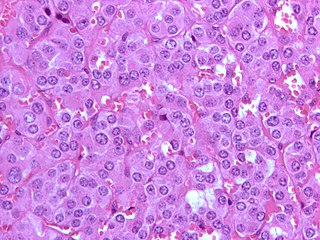
A catecholamine is a monoamine neurotransmitter, an organic compound that has a catechol and a side-chain amine.

The sympathetic nervous system (SNS) is one of the two main divisions of the autonomic nervous system, the other being the parasympathetic nervous system.

Monoamine neurotransmitters are neurotransmitters and neuromodulators that contain one amino group connected to an aromatic ring by a two-carbon chain (such as -CH2-CH2-). Examples are dopamine, serotonin and epinephrine.

Pheochromocytoma (PCC) is a neuroendocrine tumor of the medulla of the adrenal glands, or extra-adrenal chromaffin tissue that failed to involute after birth, that secretes high amounts of catecholamines, mostly norepinephrine, plus epinephrine to a lesser extent. Extra-adrenal paragangliomas are closely related, though less common, tumors that originate in the ganglia of the sympathetic nervous system and are named based upon the primary anatomical site of origin. The term is from the Greek phaios (dark), chroma (color), kytos (cell), and -oma (tumor).

Chromaffin cells, also pheochromocytes, are neuroendocrine cells found mostly in the medulla of the adrenal glands in mammals. These cells serve a variety of functions such as serving as a response to stress, monitoring carbon dioxide and oxygen concentrations in the body, maintenance of respiration and the regulation of blood pressure. They are in close proximity to pre-synaptic sympathetic ganglia of the sympathetic nervous system, with which they communicate, and structurally they are similar to post-synaptic sympathetic neurons. In order to activate chromaffin cells, the splanchnic nerve of the sympathetic nervous system releases acetylcholine, which then binds to nicotinic acetylcholine receptors on the adrenal medulla. This causes the release of catecholamines. The chromaffin cells release catecholamines: ~80% of adrenaline (epinephrine) and ~20% of noradrenaline (norepinephrine) into systemic circulation for systemic effects on multiple organs, and can also send paracrine signals. Hence they are called neuroendocrine cells.

Sympathomimetic drugs are stimulant compounds which mimic the effects of endogenous agonists of the sympathetic nervous system. The primary endogenous agonists of the sympathetic nervous system are the catecholamines, which function as both neurotransmitters and hormones. Sympathomimetic drugs are used to treat cardiac arrest and low blood pressure, or even delay premature labor, among other things.
An adrenergic agonist is a drug that stimulates a response from the adrenergic receptors. The five main categories of adrenergic receptors are: α1, α2, β1, β2, and β3, although there are more subtypes, and agonists vary in specificity between these receptors, and may be classified respectively. However, there are also other mechanisms of adrenergic agonism. Epinephrine and norepinephrine are endogenous and broad-spectrum. More selective agonists are more useful in pharmacology.

In the autonomic nervous system, fibers from the ganglion to the effector organ are called postganglionic fibers.

The celiac ganglia or coeliac ganglia are two large irregularly shaped masses of nerve tissue in the upper abdomen. Part of the sympathetic subdivision of the autonomic nervous system (ANS), the two celiac ganglia are the largest ganglia in the ANS, and they innervate most of the digestive tract.
The alpha-1 (α1) adrenergic receptor is a G protein-coupled receptor (GPCR) associated with the Gq heterotrimeric G-protein. It consists of three highly homologous subtypes, including α1A-, α1B-, and α1D-adrenergic. Catecholamines like norepinephrine (noradrenaline) and epinephrine (adrenaline) signal through the α1-adrenergic receptor in the central and peripheral nervous systems. There is no α1C receptor. At one time, there was a subtype known as α1C, but it was found to be identical to the previously discovered α1A receptor subtype. To avoid confusion, naming was continued with the letter D.

Adrenaline, also known as adrenalin or epinephrine, is a hormone, neurotransmitter, and medication. Epinephrine is normally produced by both the adrenal glands and certain neurons. It plays an important role in the fight-or-flight response by increasing blood flow to muscles, output of the heart, pupil dilation response, and blood sugar level. It does this by binding to alpha and beta receptors. It is found in many animals and some single cell organisms. Napoleon Cybulski first isolated epinephrine in 1895.
Catecholaminergic means "related to catecholamines". The catecholamine neurotransmitters include dopamine, epinephrine (adrenaline), and norepinephrine (noradrenaline).
Adrenergic cell group C1 is a group of cells that show evidence of phenylethanolamine N-methyltransferase (PNMT), the enzyme that converts norepinephrine to epinephrine (adrenalin); thus, they are regarded as 'putative adrenergic cells'. They are found in the ventrolateral medulla in conjunction with the noradrenergic cell group A1. The adrenergic group C1 is seen in vertebrates, including rodents and primates.
Adrenergic cell group C3 is a group of cells that label for Phenylethanolamine N-methyltransferase (PNMT), the enzyme that converts norepinephrine to epinephrine (adrenalin); thus, they are regarded as 'putative adrenergic cells'. They are found in the dorsal midline of the rostral medulla in conjunction with the noradrenergic cell group A3. Seen in rodents, group C3 is not detectable in most other species, including primates.
Noradrenergic cell group A5 is a group of cells in the vicinity of the superior olivary complex in the pontine tegmentum that label for norepinephine in primates, rodents and other mammals.
Catecholaminergic cell groups refers to collections of neurons in the central nervous system that have been demonstrated by histochemical fluorescence to contain one of the neurotransmitters dopamine or norepinephrine. Thus, it represents the combination of dopaminergic cell groups and noradrenergic cell groups. Some authors include in this category 'putative' adrenergic cell groups, collections of neurons that stain for PNMT, the enzyme that converts norepinephrine to epinephrine (adrenalin).
Dopaminergic cell groups are collections of neurons in the central nervous system that synthesize the neurotransmitter dopamine. In the 1960s, dopamine neurons were first identified and named by Annica Dahlström and sv:Kjell Fuxe, who used histochemical fluorescence. The subsequent discovery of genes encoding enzymes that synthesize dopamine, and transporters that incorporate dopamine into synaptic vesicles or reclaim it after synaptic release, enabled scientists to identify dopaminergic neurons by labeling gene or protein expression that is specific to these neurons.
Monoaminergic cell groups refers to collections of neurons in the central nervous system that have been demonstrated by histochemical fluorescence to contain one of the neurotransmitters serotonin, dopamine, norepinephrine or epinephrine. Thus, it represents the combination of catecholaminergic cell groups and serotonergic cell groups.
Noradrenergic cell groups refers to collections of neurons in the central nervous system that have been demonstrated by histochemical fluorescence to contain the neurotransmitter norepinephrine (noradrenalin). They are named










